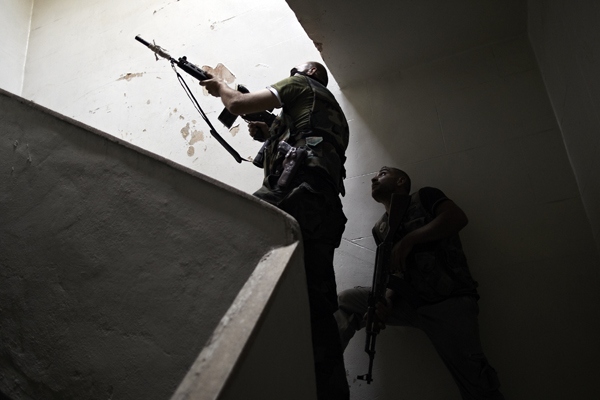Syria 1st-Hand: Who are the Al-Farouq Brigades? (Abouzeid)
 Photo: Sebastiano Tomado/SIPA USARania Abouzeid writes for Time about the Al-Farouq Brigades, a prominent force in the Syrian insurgency:
Photo: Sebastiano Tomado/SIPA USARania Abouzeid writes for Time about the Al-Farouq Brigades, a prominent force in the Syrian insurgency:
The four men had journeyed for seven hours by bus from the southern Turkish city of Antakya for a meeting they considered crucial. It was about to take place on the patio of a three-star hotel in the southeastern Turkish city of Urfa. The men — two young Free Syrian Army (FSA) commanders from Raqqa province in eastern Syria, a prominent civilian activist from the area and an FSA military adviser from the outskirts of Aleppo — were concerned with just one thing: which rebel group would control the border crossing of Tal Abyad, which had been taken less than two weeks earlier, on Sept. 19, from the forces loyal to Syrian president Bashar Assad.
In the hotel patio were more than a dozen men, representatives of various rebel groups operating in Raqqa province, drinking water and milling about several tables organized into a long row. The four warmly greeted those they knew, but there were many they clearly did not. It was 8:45 p.m. The bordercrossing was a priority, but so too was dinner. Most of the group broke awayand headed to a nearby restaurant. The four men waited on the patio, along with several others, including a man named Abu Ahmad, who had participated in the fight for Tal Abyad.
All it took was one question for the night’s schedule to be upended. “Who is now in control of the border post?” the civilian activist, Mohammad, asked Abu Ahmad. “The Farouq Brigades,” Abu Ahmad said, referring to the one of the largest, best organized and most well-known of Syria’s many military brigades.
Mohammad and his three companions exchanged exasperated glances.“Why did you all cede control to them? When did this happen? They aren’t even from here!” Mohammad said.
“We don’t want problems between revolutionaries now,” Abu Ahmad replied. “We don’t want to take them on. They said they are in control.”
And with that, just minutes after they arrived, the four men abruptly got up and left. There was nothing to discuss, they decided, giventhat the post was in the Farouq’s hands. “We as the sons of the area don’t want anyone to control the fate of our area,” Mohammad said. “The crossing is for everyone, for all the brigades that participated in its liberation, not for one group of outsiders.”
The Farouq Brigades emerged from the central city of Homs and nearby Rastan just months into the now 18-month Syrian uprising. In the period since, operating under the FSA umbrella, they have formed units across the country, from Daraa in the south near the Jordanian border to the northern region bordering Turkey. According to some of their leaders, they comprise a force of 20,000 fighters. The brigades take the name Farouq from Omar bin al-Khatab, a companion of the Prophet Muhammad, political architect of the caliphate and, historically, the second Caliph.
The brigades are both a source of envy and pride among the rebels. Dressed in their matching military fatigues emblazoned with the brigade’s black insignia, they look like a professional fighting force, unlike the many hodgepodge groups in their mismatched items of military and civilian clothing. The Farouq’s slick media operation ensures that their exploits are widely known. Their videos are quickly uploaded onto YouTube, along with the group’s statements. Most importantly, their support — both in terms of money and weapons — is strong and consistent.
As the Syrian uprising grinds on, rivalries between the disparate rebel groups have come more sharply into focus. There has always been competition for weapons, money and influence, but now they seem to be angling to take each other on — even before their common enemy of President Basharal-Assad falls. The potential for warlordism is great, and worrisome.
The Free Syrian Army was never more than an umbrella term that provided political cover for the loose franchise of defectors and armed civilians fighting Assad’s regime. It meant the difference between being perceived as part of a rebel army or a group of independent militias. New groups, or kataeb, continue to proliferate even amid efforts to unite the existing ones. Some of these kataeb consist of just 10 people. A large number of kataeb are also unaffiliated with the FSA, particularly those that exhibit varying shades of Islamist hues.
Farouq al-Shemal (or the Northern Farouq), in particular, has drawn the ire of other FSA groups operating near the Turkish border, mainly because it controls two key border posts, Bab al-Hawa (near the Turkish city of Reyhanli) which was seized in clashes in mid-July, and Tal Abyad (near the Turkish city of Akçakale).
 Al-Farouq Brigades,
Al-Farouq Brigades,  Rania Abouzeid,
Rania Abouzeid,  Syria,
Syria,  Time Magazine
Time Magazine 
Reader Comments